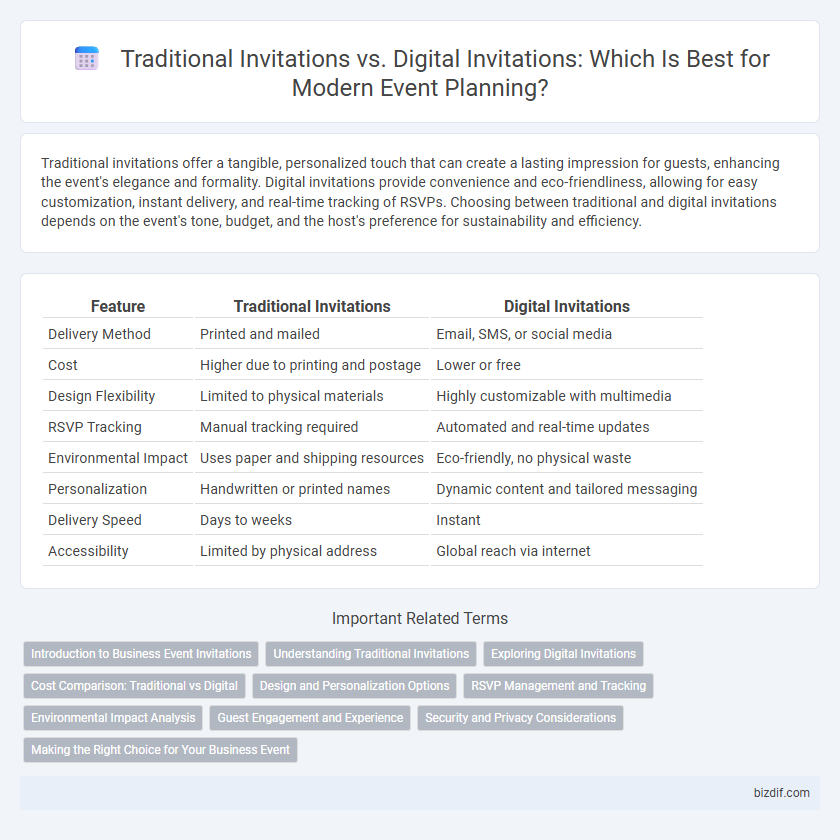Traditional invitations offer a tangible, personalized touch that can create a lasting impression for guests, enhancing the event's elegance and formality. Digital invitations provide convenience and eco-friendliness, allowing for easy customization, instant delivery, and real-time tracking of RSVPs. Choosing between traditional and digital invitations depends on the event's tone, budget, and the host's preference for sustainability and efficiency.
Table of Comparison
| Feature | Traditional Invitations | Digital Invitations |
|---|---|---|
| Delivery Method | Printed and mailed | Email, SMS, or social media |
| Cost | Higher due to printing and postage | Lower or free |
| Design Flexibility | Limited to physical materials | Highly customizable with multimedia |
| RSVP Tracking | Manual tracking required | Automated and real-time updates |
| Environmental Impact | Uses paper and shipping resources | Eco-friendly, no physical waste |
| Personalization | Handwritten or printed names | Dynamic content and tailored messaging |
| Delivery Speed | Days to weeks | Instant |
| Accessibility | Limited by physical address | Global reach via internet |
Introduction to Business Event Invitations
Business event invitations serve as a critical initial touchpoint, setting the tone for professionalism and anticipated engagement. Traditional invitations offer tactile elegance with customizable designs that convey formality and prestige to clients and partners. Digital invitations provide efficiency, instant delivery, and easy tracking, making them ideal for managing large guest lists and promoting eco-friendly practices in corporate event planning.
Understanding Traditional Invitations
Traditional invitations provide tactile, personalized experiences through high-quality paper, elegant typography, and intricate designs, which convey formality and prestige. They often include RSVP cards and physical mailing details, creating a memorable keepsake for guests. This method appeals to audiences valuing tradition and a tangible connection to the event.
Exploring Digital Invitations
Digital invitations offer enhanced customization options, real-time RSVP tracking, and eco-friendly benefits compared to traditional paper invites. Integration with social media platforms and email facilitates greater reach and instant guest communication. Utilizing digital tools streamlines event planning by providing analytics and automated reminders to ensure higher attendance rates.
Cost Comparison: Traditional vs Digital
Traditional invitations typically incur higher costs due to printing, paper quality, and postage fees, often ranging from $2 to $10 per invite. Digital invitations offer a cost-efficient alternative, eliminating printing and mailing expenses with prices usually below $1 per invitation or even free on many platforms. Budget-conscious event planners benefit from digital invitations' affordability and ease of distribution while maintaining customization and aesthetic appeal.
Design and Personalization Options
Traditional invitations offer tactile, high-quality materials with embossed or foil-stamped designs that convey elegance and formality, appealing to guests who appreciate classic aesthetics. Digital invitations provide extensive customization through interactive elements, animated graphics, and instant updates, allowing hosts to tailor designs in real time and match specific themes or color palettes effortlessly. Both formats support personalization, but digital platforms enable dynamic RSVP tracking and easy integration with social media, enhancing guest engagement and event coordination.
RSVP Management and Tracking
Traditional invitations require manual RSVP management, often leading to delayed responses and increased administrative effort. Digital invitations streamline RSVP tracking with automated reminders, real-time response updates, and easy integration with event management platforms. Using digital RSVP systems enhances accuracy, reduces no-shows, and provides actionable attendee insights for efficient event planning.
Environmental Impact Analysis
Traditional invitations consume significant amounts of paper, contributing to deforestation and increased waste, while digital invitations drastically reduce carbon footprints by eliminating physical materials. The energy used for sending digital invitations via email or social media is minimal compared to the resource-intensive processes of printing, mailing, and disposal. Favoring digital invitations supports sustainability efforts and aligns with eco-friendly event planning goals by minimizing environmental impact.
Guest Engagement and Experience
Traditional invitations create a tangible, memorable experience that often feels more personal and special, enhancing guest anticipation and engagement through physical keepsakes. Digital invitations offer interactive features like RSVP tracking, multimedia content, and instant updates, improving real-time guest communication and convenience. Balancing the tactile charm of traditional invites with the efficiency and engagement tools of digital formats can optimize overall guest experience in event planning.
Security and Privacy Considerations
Traditional invitations offer a tangible medium with reduced risk of digital hacking but can be lost or intercepted physically, posing privacy concerns. Digital invitations enable secure, encrypted communication and real-time RSVP tracking, though they require robust cybersecurity measures to prevent unauthorized access and data breaches. Selecting between the two depends on balancing the physical control of traditional mail against the advanced encryption protocols available in digital platforms.
Making the Right Choice for Your Business Event
Traditional invitations offer a tangible, formal touch that can enhance the perceived value of your business event, especially for high-profile or exclusive gatherings. Digital invitations provide cost-effective, eco-friendly options with easy tracking and quick distribution, ideal for reaching a broad audience with real-time updates. Assess your event's scale, audience preferences, and budget to determine if a classic, physical invitation or a modern, digital format aligns better with your branding and logistical needs.
Traditional invitations vs Digital invitations Infographic

 bizdif.com
bizdif.com